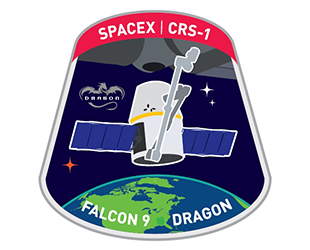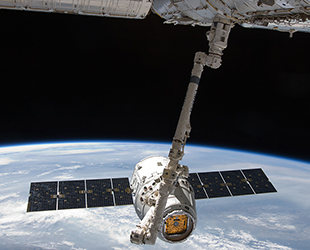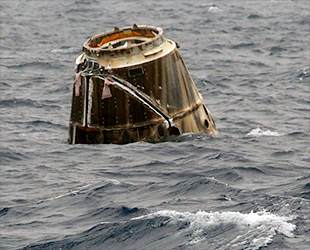October 7, 2012 — A cargo-packed, uncrewed spacecraft launched on Sunday night (Oct. 7) from Florida on the first NASA-contracted resupply flight to the International Space Station (ISS).
Space Exploration Technologies, or SpaceX, launched its second-station bound Dragon capsule atop the company's Falcon 9 rocket at 8:35 p.m. EDT (0035 GMT Oct. 8) from Complex 40 at the Cape Canaveral Air Force Station.
The Commercial Resupply Services-1 (CRS-1) flight is the first of a dozen resupply flights for which NASA is paying SpaceX $1.6 billion. The mission follows a history-making demonstration flight in May that established the Dragon as the first commercial spacecraft to berth with the station.
"[This] SpaceX launch begins a new era for spaceflight and the International Space Station," said Sam Scimemi, NASA's space station director, in a press conference held Saturday (Oct. 6). "These flights are critical to the space station's sustainment and to help begin its full utilization."
To space and back
The 14.4 foot tall (4.4 meter) by 12 foot diameter (3.7 m) gumdrop-shaped Dragon rode into space on SpaceX's two stage Falcon 9 rocket. The first stage is powered by nine kerosene and oxygen powered Merlin rocket engines. The booster's second stage uses a single Merlin to thrust the Dragon into its final orbit.
"I do know we had an anomaly on engine 1," said Gwynne Shotwell, SpaceX president, in a post-launch briefing. The live video of the launch showed what appeared to be large debris falling from the vehicle at about one minute and 20 seconds into flight.
"But the Falcon 9 was designed to lose engines and still make missions, so it did what it was supposed to do," she said.
Eleven minutes after launch, when the Dragon was safely in orbit, two 15-foot (4.6 m) solar arrays were deployed to provide power to the spacecraft.

The official insignia for SpaceX's first NASA-contracted resupply mission to the International Space Station, CRS-1. (SpaceX) |
If all proceeds as planned, Dragon will arrive at the space station on Wednesday (Oct. 10), when it will be captured and attached to the laboratory using the outpost's robotic arm for a planned two-week visit. The Dragon is scheduled to return Oct. 28 for a parachute-assisted splashdown off the coast of southern California.
The latest entry to join the international fleet of spacecraft supplying the station, Dragon is the only visiting vehicle designed to return a significant amount of supplies back to Earth, including experiments.
For CRS-1, the Dragon is packed with about 1,000 pounds (454 kilograms) of supplies, including critical materials to support the 166 science and technological investigations planned for the station's Expedition 33 crew, of which 63 are new. The payload includes 23 experiments designed by students and the first GLACIER freezer to fly on board the Dragon, which in addition to science samples, lifted off with ice cream as a treat for the station's crew.

View from the International Space Station of the SpaceX Dragon spacecraft as the station's robotic arm moves Dragon into place for attachment to the station. May 25, 2012. (NASA) |
Dragon will return to Earth with about 734 pounds (333 kg) of scientific materials, including results from physiological human research, biotechnology, materials and education experiments, as well as about 504 pounds (229 kg) of ISS hardware.
Shuttle successors
SpaceX is one of two U.S. companies awarded contracts in Dec. 2008 to provide unmanned resupply flights to the space station for NASA. The other firm, Orbital Sciences of Virginia, has a $1.9 billion contract for eight missions using its new Antares rocket and Cygnus spacecraft.
SpaceX, headquartered in California, flew three Falcon 9 rockets and two Dragon capsules before NASA approved its contracted cargo flights to begin.
On Oct. 1, Orbital rolled the first stage of its first Antares rocket to the pad at the Mid-Atlantic Regional Spaceport at Wallops Island, Va. A series of tests on the launch pad will lead to a planned test flight later this year. Orbital also plans to fly a demonstration mission to the space station to test the Antares and Cygnus in the coming months.

The first of SpaceX's Dragon capsules to visit the space station as seen after its ocean splashdown, May 30, 2012. (SpaceX) |
Both the Dragon and Cygnus are aimed at replacing an American capability to deliver and, with SpaceX's vehicle, return significant amounts of cargo, including experiments, from the International Space Station — a capability not available since the retirement of the space shuttle in 2011.
"Just over one year after the retirement of the shuttle, we have returned space station cargo resupply missions to U.S. soil," NASA Administrator Charles Bolden said in a statement after the launch. "The SpaceX launch tonight marks the official start of commercial resupply missions by American companies operating out of U.S. spaceports like the one right here in Florida."
The station is also serviced by Russia's Progress cargo capsules, Europe's Automated Transfer Vehicles (ATVs), and Japanese-produced H-II Transfer Vehicles (HTVs). All the cargo ships operate without crew members on board.
